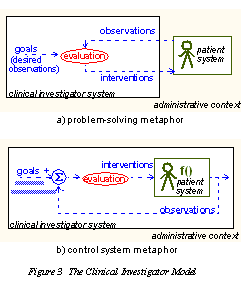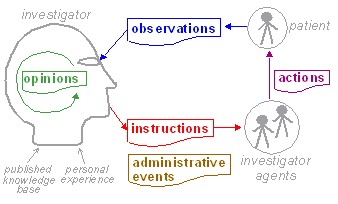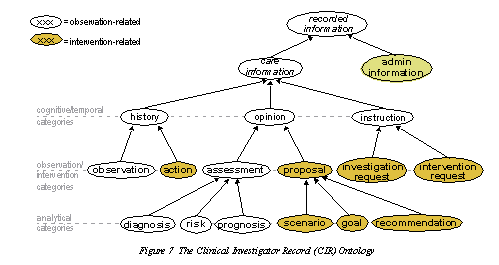...
| We model health care delivery as two kinds of process: a clinical process, corresponding to the interaction between a 'clinical investigator system' and a 'patient system', situated within a business process, which is owned by an 'administrative context'. The clinical process constitutes a sub-process of the business process, i.e. it is the main mechanism for the business process to achieve its goal, which is to satisfy a demand for care on the part of the patient. The administrative context corresponds to the health system as a whole, rather than a single enterprise, since from the patient care point of view, the mobilisation of care delivery is carried out by a network of provider organisations. The model can be illustrated in two equivalent ways, as shown in Figure 3. |
| The terms 'observation', 'evaluation' etc defined above are not themselves the same as information types, since they refer to a variety of phenomena within the process: information from observations, the activity of evaluation, acts of intervention, and goal statements. To be more precise, we are mainly interested in information created by the investigator system, since this notional agent encompasses any person or device who/which performs any healthcare related task, including the patient herself. The investigator system is therefore the creator of all clinical information in the health record, including patient-entered data. A small amount of administrative information may also end up in the EHR, generally created by non-clinical actors in the organisational context.
|
| The Clinical Investigator Record (CIR) ontology: |
...
To be continued
References
Anchor Rector1991 Rector1991
...
- Rector A L, Nowlan W A, Kay S. Foundations for an Electronic Medical Record. Methods of Information in Medicine, 1991, 30:179-186. citeseer
Anchor Austin1962 Austin1962
...
- Austin JL. How to Do Things With Words. Cambridge (Mass.) 1962 - Paperback: Harvard University Press, 2nd edition, 2005. amazon
Anchor hl7org hl7org
...
- HL7 International. Reference Information Model (RIM). See http://www.hl7.org.
Anchor weed1968 weed1968
...
- Weed LL. Medical Records, Medical Education and Patient Care. The Problem Oriented Medical Record as a Basic Tool. Cleveland: Case Western Reserve University press, 1968. google scholar amazon
Anchor Elstein1978 Elstein1978
...
- Elstein AS, Shulman LS, Sprafka SA. Medical problem solving: an analysis of clinical reasoning. Cambridge, MA: Harvard University Press 1978. amazon
Anchor Tange2003 Tange2003
...
- Tange HJ, Dietz JLG, Hasman A, de Vries Robbé PF. A Generic Model of Clinical Practice - A Common View of Individual and Collaborative Care. Methods of Information in Medicine 3/2003. Schattauer GmbH. complete article
Anchor Bruun2005 Bruun2005
...
- Bruun-Rasmussen M, Bernstein K, Vingtoft S, Nøhr C, Andersen SK. Quality labelling and certification of Electronic Health Record Systems. Studies in Health Technology and Informatics 2005; 116: p47-52. pubmed
Anchor Areblad2005 Areblad2005
...
- Areblad M, Fogelberg M, Karlsson D, Åhlfeldt H. SAMBA - Structured Architecture for Medical Business Activities. In: Engelbrecht R, et al. (editors) Connecting Medical Informatics and Bio-Informatics. MIE 2005: Proceedings of Medical Informatics Europe; 2005 Aug 28-31; Geneva, Switzerland. p. 1225-30.
Anchor Beale2000 Beale2000
...
- Beale T, Heard S. The GEHR Object Model - Technical Requirements. 2000. complete document.
Anchor Riche1992 Riche1992
...
- RICHE Consortium. RICHE ESPRIT Project. Final Report. Nov 30 1992.
Anchor Ingram1995 Ingram1995
...
- Ingram D, Lloyd D, Kalra D, Beale T, Heard S, Grubb, P, Dixon R, Camplin D, Ellis J, Maskens A. Deliverable 19,20,24: GEHR Architecture. GEHR Project 30/6/1995. complete document.
Anchor Grenon2004 Grenon2004
...
- Pierre GRENON, Barry SMITH and Louis GOLDBERG. Biodynamic Ontology: Applying BFO in the Biomedical Domain. From D. M. Pisanelli (ed.), Ontologies in Medicine, Amsterdam: IOS Press, 2004, 20-38. complete article
Anchor Beale2007 Beale2007
...
- Thomas Beale, Sam Heard. An Ontology-based Model of Clinical Information. pp760-764 Proceedings MedInfo 2007, K. Kuhn et al. (Eds), IOS Publishing 2007.


